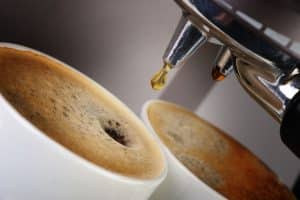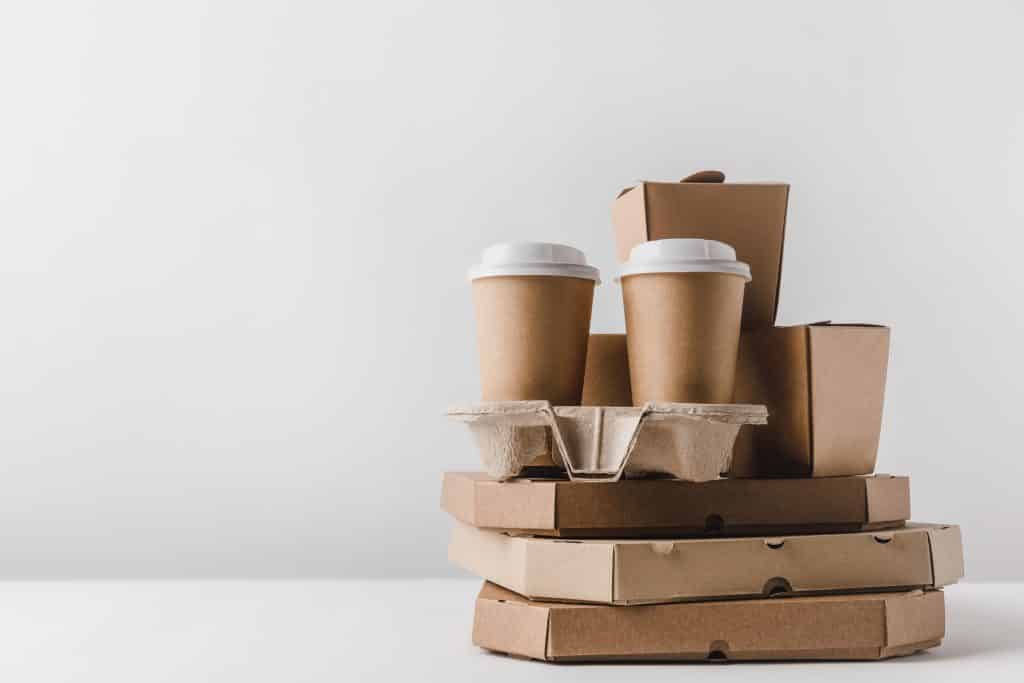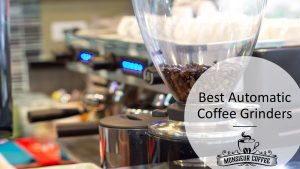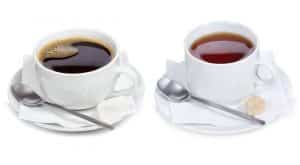
Can you make regular coffee with an espresso machine?
For most adults, having a hot cup of coffee in the morning is how the day starts. From percolators to drip brew coffee pots to
The perfect start of the day involves a good cup of coffee for most people. I know it does for me! But if the coffee you make at home doesn’t taste good? What if it tastes like cardboard?
Yuck!
But don’t immediately run to the nearest Starbucks! You can make great coffee at home at a fraction of the cost of a take out coffee. And usually, it tastes way better.
Coffee tasting like cardboard is disgusting. But what makes coffee taste like cardboard? The most common causes for a cardboard or paper taste in coffee are: a paper filter that has not been rinsed with water or the use of inferior quality coffee beans.
Those are the most common causes. But there are more. And there are ways you can prevent your coffee from tasting like cardboard. Read on for more!

A cardboard taste in coffee can have multiple causes. Let’s dive in and find out more about each.
A lot of common coffee brew methods use paper filters to separate the liquid from the ground coffee. Fancy pour-over coffee, a Chemex, and even the excellent (and even Sci-Fi, in my opinion) Aeropress coffee maker all use paper filters. And let’s not forget the trusty drip coffee maker.
In fact, even in a time when the Keurig coffee pods seem to reign supreme, about 45% of all homemade coffee in the U.S. is made with a drip coffee maker (source: link). So, over 45% of homemade coffee in the U.S. is made using a paper filter.
For most people, making coffee with a coffee maker involves pouring water into the machine, inserting a paper filter, loading it up with ground coffee, and flipping a switch.
If that is you, and you have a cardboard taste to your coffee, consider this. Most paper filters, especially the white, bleached ones, can deposit paper or cardboard flavor compound in the brewed coffee.
In the specialty coffee world, rinsing out a paper filter is common practice. But most people who make coffee at home with a drip coffee maker don’t do this. And that’s fine as long as your coffee tastes good.
But if you are suffering from coffee-tastes-like cardboard syndrome, rinsing your paper filter before you put in the ground coffee, might fix your problem.
The freshness of coffee has a massive impact on the taste of the final brew. Most ground coffee you find at the supermarket is not fresh. It has been sitting on the shelves of the supermarket for days, at least. Before that, it probably sat in the warehouses of the supermarket and the manufacturer for weeks, if not months.
By the time you open the packaging, the coffee might be weeks to months old. That cannot be called fresh by any standard. No amount of vacuum packaging can do anything about that.
Additionally, coffee starts to lose a lot of its flavor pretty soon after it has been ground. Therefore, most specialty coffee shops (and coffee nerds like me) grind the coffee bean only moments before using it.
A lot of people buy dark roast coffee. What they want is the ‘strongest’ cup of coffee possible. It is a common misconception that dark roasted coffee has more flavor and more caffeine. It doesn’t.
If anything, dark roasted coffee has less flavor than medium or even light roasted coffee. A lot of the complex flavor compounds in coffee beans get burned off when they are roasted for (too) long. What you do get is a coffee with more pronounced roasting flavors and a coffee that is more bitter to the taste.
The caffeine levels in any level of roast are the same (provided the same coffee beans are used).
When coffee beans are roasted, they are heated in a spinning drum. The spinning of the drum in a professional coffee roasting machine.
Green coffee beans can be stored for some time, longer than roasted beans. But not too long. Green beans that sat for too long can taste like cardboard after roasting.
If you roast your own coffee beans, be sure to check your green beans. Important information is when and where they have been harvested and processed. If the harvest date is longer than one year ago, the green coffee beans are no longer fresh. Their quality could still be good enough to make a fine coffee. Still, the changes in quality and flavor will have become noticeable. So, it is best to avoid green beans that are over one year old.
The way green beans have been store also impacts their quality. If the coffee beans were harvested less than a year ago but weren’t adequately protected from moisture, they might have gone bad. Just as with roasted coffee beans, moisture is the enemy when storing beans.
There is really nothing you can do about this. You would need to know about the weather conditions during the growth of the coffee plant. If the coffee plant was exposed to excessive heat or an extended period of drought while the coffee cherries were growing, they might develop off-flavors.
Yes, this means coffee can have a bad year or a good year. Just like wine, the flavor of coffee beans is influenced by the “terroir” (i.e., the soil composition and weather conditions of the area where they were grown).
Besides identifying why your coffee might taste like cardboard, it might be helpful to take the following steps to prevent any cardboard flavors. These steps not only prevent cardboard flavor but are good steps to take to make the best coffee you can. Whichever brew method you use.
If you use dirty coffee making equipment, you will get noticeable off-flavors at some point. Coffee contains oils that deposit gunk on your equipment while brewing.
Water (especially hard water) contains dissolved compounds of calcium and magnesium. These deposit on your equipment and are called scale and will clog your equipment and cause off-flavors eventually.
Therefore it is vital to keep your coffee making gear clean. Rinse with warm water after use, don’t let used filters sit in a filter holder, and periodically clean with soapy hot water. This goes for brewing equipment like a coffee cone (e.g., Hario V60, Kalita, Chemex), a drip coffee maker, but also your Keurig or Nespresso single-serve coffee maker.
And don’t forget your grinder (if you are using one). Grinders are also prone to collecting oil deposits from ground beans. These oil deposits will turn rancid over time and transfer off-flavors to the fresh beans you’re grinding. You should clean out coffee bean residue after each grind (or once a day if you grind more than once a day). At least once a month, clean any parts that are removable from the grinder (or the whole disassembled grinding in case of a manual coffee grinder) with a solution of warm water and a mild detergent.
In short, keep it clean!
We have seen that paper filters can deposit cardboard-like off-flavors in your coffee. To prevent this, it is good practice in the specialty coffee industry to always rinse a paper filter with hot water.
For some, this practice hasn’t really been adopted by people who make coffee at home with a drip coffee maker. But believe me, it makes all the difference. Yes, it is more work. But worth it!
Before you load you drip coffee maker with ground coffee, run the coffee maker with only a filter in the basket. If your coffee maker has an auto stop (which prevents the liquid from running through when the carafe is not placed), keep your carafe out. This allows the basket with the filter to fill up with hot water and give the filter a really good rinse. When the water fills the basket halfway, or when the machine has been running for a minute, and the filter is all wet, shut it off and let the water drain.
The just fill the machine with the proper amount of water and ground coffee and brew as you always do.
Using coffee that is fresh is the next step in making a good cup of coffee that doesn’t taste like cardboard. As said, coffee on the shelves of supermarkets could be months old.
If you get your coffee at the supermarket, and you can’t or won’t buy it anywhere else, you should consider buying whole bean coffee instead. Whole coffee beans stay fresh for much longer than preground coffee. In my opinion, switching from preground coffee to whole bean coffee is the single best thing you can do to improve the quality of the coffee you make. And it doesn’t matter whether you get you whole coffee beans from the supermarket or from a fancy artisan coffee roaster. Whole bean coffee makes better coffee than preground coffee.
If you consider switching to whole bean coffee, but don’t own a coffee bean grinder, check out our buying guides for manual coffee bean grinders or (if you have a little more to spend) automatic coffee bean grinders.
If you want to stick with preground coffee, that’s fine. Sometimes convenience wins. But try to get the freshest coffee you can. Most specialty coffee shops or small roasteries will grind the coffee beans you buy there for you, no problem.
Dark roasted coffee is not more flavorful than a medium or light roasted coffee. If anything with a dark roast, you run the risk of burning off the desirable flavor compounds in the coffee bean. Also, dark roasted coffee off lesser quality is often literally burnt. This introduced off-flavors like cardboard.
So, if you are experiencing cardboard-like or any other type of off-flavors in your coffee and you are using dark roast. Try a medium roasted coffee. Just once. I pretty much guarantee you will not turn back.
We have touched on this at step #3: grinding your own coffee beans can help the flavor of your coffee tremendously. Fresh coffee bean, ground just before use are very unlikely to produce cardboard flavors.
Another thing to keep in mind is to grind your coffee beans to the right size. Espresso requires a very fine grind, while French Press coffee is made with a relatively coarse grind. Match the grind size to the brew method. That will produce the best results without any cardboard flavors (or any other off-flavors).
Using water that is too hot while brewing, can burn the ground coffee. Using water that is too cold will lead to under extraction. In any case, brewing coffee with water that is either too hot or too cold will produce off-flavors. One of which can be the cardboard flavor we are trying to avoid.
A good rule to follow is to brew coffee with water that is between 195 and 205 degrees Fahrenheit (between 90 and 96 degrees Celsius). Water temperature is one of the variables barista’s use to get the most flavor out of a coffee bean. Every coffee bean variety has different optimal water temperature. As does every size ground coffee. But that’s a whole different ball game.
Using water that is between 195 and 205 degrees Fahrenheit (between 90 and 96 degrees Celsius) will ensure you don’t burn or under extract the coffee and avoid off-flavors.
MonsieurCoffee.com is a participant in the Amazon Services LLC Associates Program, an affiliate advertising program designed to provide a means for sites to earn advertising fees by advertising and linking to Amazon.com. We earn small commissions on purchase made through links on this site, at no extra costs to you.

For most adults, having a hot cup of coffee in the morning is how the day starts. From percolators to drip brew coffee pots to

Grinding your coffee right before you brew it is probably the best thing you can do to improve the quality of the coffee you make.

I had a discussion with a friend the other day. He stated that coffee is actually a tea. I was dumbstruck. How can you say

Ever wondered, when you pour your steaming morning cup of joe: what exactly is coffee? It’s black, tasty (I hope) and energizing. But WHAT is